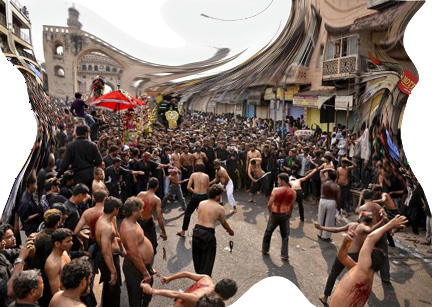
The most potent symbol of the history of the Middle East, indeed of much of human history, is the stuff of life itself: blood. In the sacred history of the three major monotheisms enough blood has been shed since their inception (by and against each one of them) to raise the sea level meters upon meters. Even in the Genesis origin story the first two natural births, Cain and Abel, became the first to introduce bloodshed as a norm. The God of Genesis got into the act, killing animals to make skins that would clothe the naked bodies he created of Adam and Eve and then preferring the animal sacrifice of Abel to the firstfruit figs raised by Cain. The same God went on to substitute a lamb for Abraham’s heir, although only when Abe’s knife was poised to slit his son’s throat, but then in Christian dogma the now-threefold deity shed a third of his essence on the cross. In that same dogma Jesus no longer needs that lost blood as he resurrected to make the trinity a divine threesome once more. But the bloodletting has never stopped.
By all accounts the prophet Muhammad was not fond of shedding blood. The forays and battles that took place while he and his followers were in exile in Medina are remarkable for how few deaths are said to have occurred. When he returned in triumph to Mecca it was not because of any great military victories, nor was their a bloodbath of the Meccans. At the start of Islam the Allah seen through the Quran is neither interested in literal blood sacrifices or a figurative eucharistic variety. Muslims purify themselves with water to make themselves ready for prayer. Calls for jihad have resonated throughout the Islamic era as countless thousands upon thousands have died for not being Muslim, being Muslim or being the wrong kind of Muslim: such is the political baggage common to most religions known to history and probably before recorded history.
Today the blood is still hemorrhaging throughout the Middle East, mostly in areas where Muslims live. The worst flow at the moment is in Syria, where politics pits Muslims against each other and catches Christians and Druze in the crossfires. Bombs with sectarian intent go off daily in Iraq and Afghanistan. Riots in Cairo open wounds. Libya is hardly a pacifist paradise. The blood that surges out from gunfire and cluster bombs is always politically charged. The suicide bomber, no matter what the rationale, is no less a weapon than an AK-37.
So much blood is being shed, that we almost forget the self-inflicted wounds, not with intent to take others’ blood but to purposefully and metaphorically purge one’s own. I am speaking of an event that some of the shi’a persuasion perform on the 10th of Muharram, which recently occurred around the time of the American Thanksgiving. For the shi’a this is the day commemorating the martyrdom of Hussain, where the prophet’s grandson and his followers were murdered on an Iraqi plain in a prolonged fight for control of the faith. It is telling of the age-old rivalry between Muslims over this act that in the time of the prophet the month of Muharram was one in which no fighting was to take place. The truce month has been trampled in subsequent politics with no end, apart from a hoped-for Yawm al-Qiyama, in sight.
For the rest of this commentary, first posted on Anthropology News, click here.